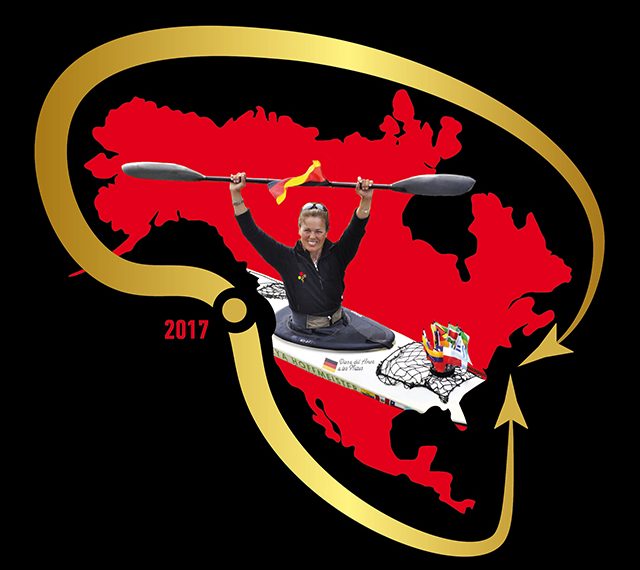Pos: here
Loc: Huanchaco
Acc: tent
Dist: 46,7 km
Start: 6:30 End: 14:25
Tomorrow:
Estimated landing: Puerto Malabrigo
Estimated starting time: Right after sunrise
Estimated landing time: Well before sunset
We again took our time in the morning to leave our dream beach – only another 45 km to go to Huanchaco to pick again some fresh water.
The night we got a visit from two stray dogs which we already yesterday spotted at the next beach from our high mountain top walk. They were barking their souls off, but my earplugs were stronger. When they stopped at some point, you may think they would be gone? The tracks next mornings showed they were strolling quietly around our tent, and I didn’t hear them barking close by…
Our first spot to head for on crossing again a wide bay was a (pearl)shell farm. A bunch of floats everywhere, a working house on a platform, four moored boats with one guy working. Not too exciting.
The sea was dead calm again, with a low following breeze…we are really getting spoiled the last days! The paddling speed was accordingly good, and I was already wondering what to do with the afternoon off again, this time probably on a city beach. It was Sunday, and the first time we saw a bit of beach life in Peru! Actually too much of a beach life, as the calm landing area around the jetty was packed with beach life, and we opted to rather do a bit of a surf landing to go to the end of the city where we could camp quietly. Peter would walk to shop for water again, and just in case take a taxi back “home”.
But before landing, we had a “kayak” encounter of the local historical sort: A straw bundle kayak, called “capallitos de tortora”, means “little horses”. They are hard to describe, paddled with a lengh wise split large bamboo stick. The local guy was checking on fishing nets he had put outside the surf. He either was sitting, or kneeling on the craft, and was happily interested in our kayaks and up for pictures. Coming soon!
When we slowly paddled into Hunachaco beach, he fortunately said good bye, as we first didn’t like to paddle right into the beach life where a line of more of those “kayaks” were proving this kind of fishing method is still quite commonly practised here, and secondly we rather like to put on helmet and PFD for our landing which may go through some surf. The local must have been quite confident with his surf landing, as his catch of the day, two big fish, was lying loose on the boat, and he put my card under his hat to keep it dry…
Our landing was eventually at the end of the city, but through quite a surf belt we so far always likedpreferred to avoid…but as the sea was generally low, the surf was also not powerful. Still some rollers crashing in! But we both made it in dry, although later we thought the surf was rising and it may be hard to get out again. Last option is to carry everything two hundred meters back into the calmer jetty corner…
We made camp in a nice “private” corner, right besides the “private” corner of the old traveller Javier with white beard and hair looking like an Indian guru, obviously now living on the beach in a “tent” out of a tarp and cardboard. He was friendly and spoke perfect English, telling a bit out of his previous life. He now makes his living by paintings and writing, but I rather felt like sharing some of our food with him!


5 comments on “Sun 02/12-2012 Day 347”
Thanks Ricardo Caballitos de totora -very interesting, some really great info on youtube as well.
Interesting about the pearl farm and the reed kayaks. Im sure the nice old Perivian artist fellow had some intersting life to tell of.Good to hear you had a nice day and dry landing.Now if the same will be true on your launch through possible rough surf in the morning.Cant let the Reed Kayak fisherman out do you two.Ha.Safe Paddling.
I can’t wait to see your pictures of the ‘little reed horse,’ Freya. Thank you, Ricardo, for your post.
An ease full day. Sounds good Freya. Thank you Ricardo for the write up on the reed watercrafts.
I hope you did offer him some food. Everybody is on their own path.
Karen
Look what Wikipedia says about these beautiful “Caballitos de Totora” kayaks Freya is describing here: “Caballitos de totora are reed watercrafts used by Peruvian fishermen for the past 3,000 years, archaeologically evidenced from pottery shards.
Named for the way they are ridden, straddled (‘little reed horses’ in English), fishermen use them to transport their nets and collect fish in their inner cavity. The name is not the original name as horses were not introduced to South American until after the Spanish arrived in the 15th Century. They are made from the same reed, Scirpus californicus, used by the Uros in the Lake Titicaca region.
Fishermen in the port town of Huanchaco famously, but in many other locations practically, still use these vessels to this day, riding the waves back into shore, and suggesting some of the first forms of wave riding. There is currently a minor debate in the surfing world as to whether or not this constitutes the first form of surfing.”
Comments are closed